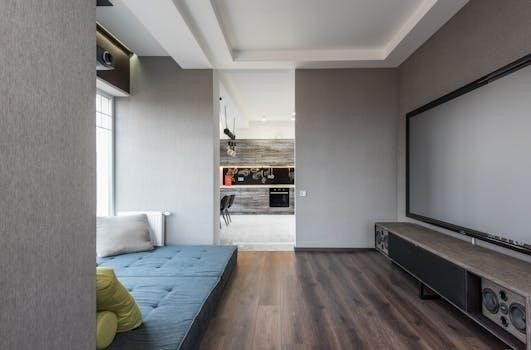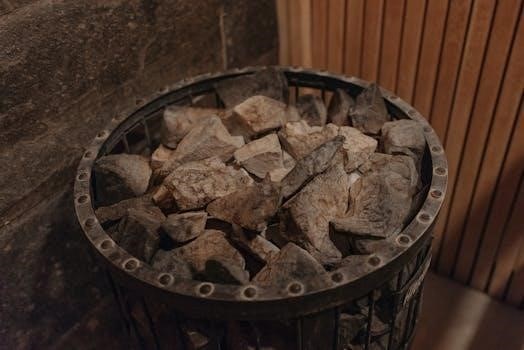Comfort Zone heater manuals are essential guides for proper use and maintenance. These manuals provide valuable information, ensuring safe and efficient operation. They detail specific model features, operational procedures, and vital safety precautions, helping users get the most from their heaters.
Overview of Comfort Zone Heater Models
Comfort Zone offers a diverse range of heater models designed to meet various heating needs. These include digital quartz infrared heaters, known for their efficient and quiet operation, often featuring multiple heat settings and energy-saving modes. Some models incorporate fan-forced heat circulation for wider distribution, and many include remote controls for convenient operation. You’ll find portable ceramic heaters, ideal for personal spaces, and industrial-grade heaters suited for larger areas. There are also ceiling-mounted heaters available, designed for more permanent installations. Models vary in size, power output, and features, such as timers, adjustable thermostats, and safety locks. Manuals cover specific model variations, like oak, cherry, walnut, and black finishes, ensuring users have the right information for their particular unit. The models also include oscillating tower designs, and some even offer remote control capabilities. Always refer to the specific manual for your model.

Safety Precautions
Prioritize safety when using your Comfort Zone heater. Always read the manual carefully. Heaters have hot parts; avoid flammable materials. Ensure proper electrical connections and never use extension cords.
Important Safety Instructions Before Use
Before operating your Comfort Zone heater, carefully read the entire owner’s manual. This action is crucial for understanding its safe and effective use. Always ensure the heater is placed on a stable, level surface to prevent tipping. Never operate the heater in areas where flammable liquids or vapors are present. Keep all combustible materials, such as furniture and curtains, away from the heater. It is essential to avoid placing anything on top of the heater. Check that your electrical wiring is in good condition and meets the necessary codes. Only use a 120V AC outlet. Inspect the power cord for damage before each use. Never use an extension cord. This can cause overheating and pose a fire hazard. Be aware that heaters have hot and sparking parts. Do not attempt to repair the heater yourself; contact customer support for any issues. This is crucial for your safety and the longevity of the appliance. Finally, remember to keep children and pets away from the operating heater.
Proper Heater Placement
Proper placement of your Comfort Zone heater is vital for both safety and optimal heating performance. Always position the heater in an upright position, following the guidelines provided in the manual. Place the heater in the coldest area of the room to ensure effective heat distribution. Avoid placing the heater near walls, furniture, or curtains that could obstruct airflow. It’s also important to ensure a minimum of 3 feet clearance around the heater. Do not position the heater in high-traffic areas or where it could be easily knocked over; Never place the heater in a bathroom or other humid environment. The heater is intended for indoor residential and office use only. Avoid using it in industrial or commercial spaces. Ensure the heater is placed on a stable, level surface to prevent accidental tipping. Proper placement ensures efficient heating and reduces fire hazards. Keep the heater away from water sources and do not use it in wet areas.
Electrical Connection Guidelines
When connecting your Comfort Zone heater, adhere strictly to the electrical guidelines provided in the manual. Ensure the heater is plugged directly into a 120-volt AC, 60 Hz wall outlet. Always check that the plug fits tightly into the outlet to prevent overheating. Verify that the electrical wiring is in good working order and meets all applicable codes and ordinances. Never use an extension cord, as it could overheat and pose a fire risk. If necessary, use an adapter to connect a three-blade grounding-type plug to a two-slot receptacle, ensuring the grounding lug is connected to a proper ground. Do not plug the heater into a damaged or loose outlet. The heater must not be connected to a power source other than what is specified in the manual. Inspect the power cord for any signs of damage before each use. Avoid overloading electrical circuits by not connecting other high-power appliances to the same outlet. These guidelines ensure safe and reliable operation of your Comfort Zone heater.

Operating Instructions
This section covers powering on your Comfort Zone heater, selecting desired modes, setting the timer, and utilizing the remote control. Follow these instructions for optimal and safe operation.
Powering the Heater On and Selecting Modes
To begin, ensure your Comfort Zone heater is placed on a stable, level surface. Locate the power button on the control panel or remote; press it to turn the unit on. Once powered, various heating modes are available, typically low, high, and energy-saving. Use the ‘MODE’ button to cycle through these settings. Each mode is designed for different heating needs, with high providing maximum heat output and low offering gentler warmth. Energy-saving modes often utilize lower power consumption. The indicator lights on the control panel will show the current selected mode. Adjust the settings to match your comfort preferences, ensuring to follow all safety guidelines. Always refer to your specific manual for precise mode names and their energy consumption.
Setting the Timer
The Comfort Zone heater’s timer function allows you to set a specific duration for the unit to operate before automatically powering off. To set the timer, first ensure the heater is powered on. Locate the ‘Timer’ button on the control panel or the remote control; pressing this button will typically initiate the timer setting mode. Use the ‘Temp Up’ and ‘Temp Down’ buttons to adjust the desired time, usually in one-hour intervals. Once the desired duration is selected, the timer will be set, and the heater will operate for the programmed duration before switching off. The timer is useful for saving energy and ensuring the heater is not left running unattended. Always check the display to confirm the timer is set correctly and that it is operating within the limitations mentioned in the user manual. The timer can be canceled by pressing the ‘Timer’ button again or by turning the unit off.
Using the Remote Control
The Comfort Zone heater remote control provides convenient operation from a distance. The remote typically mirrors the functions available on the heater’s control panel. An ‘ON/OFF’ button powers the heater on or off. Temperature adjustment is done via ‘Temp Up’ and ‘Temp Down’ buttons, allowing you to increase or decrease the desired room temperature. The ‘Mode’ button allows toggling between different heat settings, such as low, high, or energy-saving modes. A ‘Timer’ button is usually present to set the auto shut-off timer. Some remotes might have additional buttons for specific features, such as fan mode. The remote control requires batteries, and it is essential to replace them when they run low. Point the remote at the heater’s sensor for proper operation. Ensure there are no obstructions between the remote and the heater. The remote control should be used within a reasonable distance for optimal performance.

Maintenance and Troubleshooting
Proper maintenance ensures your Comfort Zone heater functions efficiently and safely. Regular cleaning and knowing how to address common issues are crucial for extending its life and preventing problems.
Cleaning and Storage
To ensure the longevity and optimal performance of your Comfort Zone heater, regular cleaning is essential. Before cleaning, always unplug the unit and allow it to cool down completely. Use a soft, damp cloth to wipe the outer shell, removing any dust or dirt. For stubborn stains, a mild detergent can be used. However, it’s crucial to avoid letting any liquid enter the heater’s internal components. After cleaning, ensure the unit is thoroughly dried with a soft cloth. When storing your heater, choose a cool, dry location to prevent moisture damage. If possible, use the original packaging to protect the unit from dust and dirt. Before long-term storage, remove the remote control battery. Proper cleaning and storage practices will keep your heater in good condition and ready for its next use, ensuring safe and reliable operation for years to come.
Troubleshooting Common Issues
If your Comfort Zone heater isn’t functioning correctly, begin by checking the power connection; Ensure the unit is properly plugged into a working outlet and that the plug fits tightly. If the heater doesn’t power on, verify that the circuit breaker hasn’t tripped. For units with remote controls, replace the batteries to rule out a power issue. Should the heater produce little or no heat, confirm that the selected power mode is appropriate for the space. Inspect the heater’s air intake and exhaust areas for any obstructions. If the heater overheats, discontinue use immediately and allow it to cool, ensuring no flammable materials are nearby. If these steps do not resolve the problem, refer to the model-specific manual or contact customer support for further assistance. Avoid attempting complex repairs yourself, as this could void the warranty.

Warranty and Support
Comfort Zone heaters typically come with a limited warranty. For support, contact customer service with your model details and purchase date. Check your manual for specific warranty terms and contact details.
Warranty Information
Comfort Zone provides a limited warranty on its heaters, typically covering defects in materials and workmanship. The warranty period may vary depending on the specific model and region of purchase, so it is vital to refer to the documentation included with your heater. The warranty usually begins from the original date of purchase. To claim warranty service, you will generally need to provide proof of purchase, such as a sales receipt or invoice. The warranty does not cover damages caused by accidents, misuse, improper voltage, or unauthorized modifications or repairs. If your heater malfunctions during the warranty period and the issue is covered under warranty, Comfort Zone will typically repair or replace the unit at their discretion. Please carefully review your heater’s warranty details for specific terms and conditions, as this information is crucial for understanding your rights and responsibilities. Keep your purchase documents in a safe place for warranty claims.
Contacting Customer Support
If you encounter any issues with your Comfort Zone heater or have questions about its operation, their customer support team is readily available to assist you. For inquiries, you can typically reach them through several channels, including email, phone, or their website’s contact form. When contacting customer support, be prepared to provide your heater’s model number, purchase date, and a detailed description of the problem you are experiencing. This will help the support team provide efficient and effective assistance. Many manufacturers also have a Frequently Asked Questions (FAQ) section on their websites, which may provide answers to common questions or troubleshooting steps. If you prefer direct communication, a phone call may be the best option; Always consult your heater’s manual or the manufacturer’s website for the most up-to-date contact information, as it may change from time to time. Promptly contacting customer support can help you resolve your issues quickly and efficiently.
